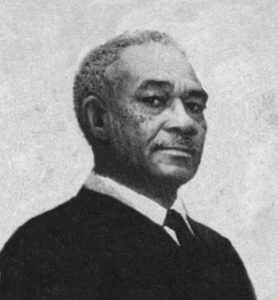
Robert S. Pious
*Robert Savon Pious, a black graphic artist, was born on this date in 1908 in Meridian, Mississippi.
His father was Nattie Pious, and his mother was Loula Pious. His parents married in 1895 and had nine children, of which he was the sixth born. The family lived at 2005 18th Avenue in Meridian. At the turn of the 20th century, Meridian was the largest city in the state and a leading center of manufacturing in the South. The city had grown prosperous because it was located in Eastern Central Mississippi, where two major railroads intersected, the Southern Railway and the Mobile & Ohio Railroad. His father worked as a laborer in the busy rail yard of Union Station.
In 1914, his father died. In 1915, his mother married her second husband, Henry Coleman, from Illinois. The family moved to St. Louis, Missouri, at 2246 Washington Avenue. His stepfather became a Furnace Fireman at a local manufacturing plant, while his mother worked as a Laundress. A tenth and eleventh child were born while the family lived in St. Louis. In 1921, the family moved to Chicago, IL, where they lived at 69 Fifty-ninth Street. He attended high school in Chicago, where helpful art teachers nurtured his drawing talent. In 1926, he graduated high school and was encouraged to seek advanced academic art training; that same year, his stepfather died at fifty-four.
In 1927, Pious began to attend the Art Institute of Chicago while working full-time nights in the press room of a Chicago printing plant, the Cuneo Press. While working with printed media, he became interested in a newspaper cartoonist and advertising artist career. He began to draw black and white illustrations for Continental Features, a supplier of material for newspapers catering to Black readers. He contributed editorial cartoons, advertisements, and illustrations to this company for the rest of his life. In 1928, he married Ruth G. Mitchell, a freshman at a college in Chicago. The newlyweds moved to 6352 Langley Avenue in Chicago. In 1929, he completed his second year of study at the Art Institute of Chicago but left school to work as a freelance commercial illustrator.
Along with his work for Continental Features, he painted portraits of celebrities, entertainers, and the high society of Chicago's booming Black community. In 1929, one of his portraits won an award from the Harmon Foundation in New York City. This official recognition helped to promote his reputation as a promising artist. In 1931, he was awarded a four-year scholarship to study at the National Academy of Design in New York City. He moved to Manhattan and lived at 446 St. Nicholas Avenue, near 133th Street in Harlem. After completing her second year of college in Chicago, his wife quit school and joined him in NYC. His portraits of noteworthy Blacks soon appeared on the covers of Opportunity: A Journal of Negro Life. While living in Harlem, he met the sculptress Augusta Savage, whose studio was a popular fixture in the Harlem Artists Guild.
He met other important artists from the Harlem Renaissance art movement there, such as Ernest Chrichlow, Charles Alston, Norman Lewis, Joseph Delaney, Romare Beardon, and Jacob Lawrence. At that same time, he met Charles C. Seifert, a scholar of African history, who became his mentor and inspired him to explore historical subjects of African ancestry. During the 1930s, he was a muralist for the WPA Federal Art Project, an enlightened government program providing artists relief income.
The WPA also funded him to teach art at the Harlem branch of the Y.M.C.A. In 1936 he designed the poster for the world's fair, The Texas Centennial Exposition, which was held in Dallas and included a Hall of Negro Life, one of the earliest mainstream celebrations of Black history. In 1940 he won first prize in a poster competition for his design for The American Negro Exposition, which marked the jubilee of the abolition of slavery. The award was presented to him at City Hall by Mayor Fiorello La Guardia.
During the 1940s, Pious was an artist and celebrity whose activities were reported in the Black media, along with popular athletes, entertainers, business tycoons, and socialites. During WWII, he worked under contract as an illustrator for the Office of War Information. From 1943 to 1949, his pen and ink drawings appeared as story illustrations in pulp magazines. His work appeared in Sky Raiders, Exciting Sports, Exciting Football, Popular Football, Sports Fiction, Super Sports and Sports Winners. From 1940 to 1953, R. S. Pious worked for many Golden Age comic book publishers, such as Street & Smith, Fiction House, Ace Periodicals, Archie, Chesler Studio, Novelty Comics, and Victory Comics. In the 1950s, he illustrated books for several publishers, including Grosset & Dunlap, Whitman Publishing, Harvey House, Random House, Funk & Wagnalls, and Bobbs-Merrill Publishing Company.
Throughout the 1960s and 1970s, his portraits appeared regularly on the covers of the National Scene, a weekly magazine distributed nationwide as a Sunday supplement in many Black newspapers. His artistic achievements brought him even wider recognition and celebrity in his final years. He was popular enough to appear in an advertised product endorsement for Lucky Strike cigarettes. In the 1970s, the Pious moved to a large apartment building at 801 Tilden Avenue in the Bronx, NYC, where they lived on the twentieth floor with a spectacular view of the NYC skyline. His portrait of Harriet Tubman is displayed at the Smithsonian Portrait Gallery in Washington, D.C. Robert S. Pious died in the Bronx at seventy-four on February 1, 1983.